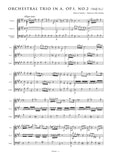Stamitz, Johann: Orchestral Trio in A major, Op. 1, No. 2 (AE040) – sheet music
Previous Product Next Product
Description |
Stamitz, Johann (1717-1757)
|
||||||||||||||||||
Audio sample |
|||||||||||||||||||
Details |
Hugo Riemann classed the orchestral trios with Stamitz's symphonies probably on the strength of their high musical quality. Eugene Wolf 's more recent analysis of the works, however, argues "that for Stamitz they occupied a well-delineated middle ground between chamber trio and symphony, generally avoiding both the melodic intricacy of the chamber style and such common symphonic traits as slow harmonic rhythm , simplified texture and conspicuous use of crescendo passages". From a stylistic perspective, the trios represent a deliberate adjustment between Stamitz's familiar large-scale orchestral style and the intimacy of the chamber idiom and for this reason he no doubt directed the engraver, Mlle Vendme, to describe the works as being suitable for performance by a trio or by a full orchestra. The title page of the Op. 1 Trios reads: "SIX / SONATES / - Trois parties concertantes qui sont / faites pour Excuter ou trois, ou / avec toutes l'Orchestre / DDIES / A The Right honourable / Mylord Pittenweem / PAR JEAN STAMITZ / Directeur de la Musique de S: A: Sme Monseigneur / L'Electeur Palatin..." All the orchestral trios appear to be relatively late works, probably dating from around 1754-55. The six Trios Op.1, which appeared in 1755 or early 1756, were Stamitz's first published works and proved highly influential throughout Europe. Cast in four movements, like many of his later symphonies, the Op.1 Trios are attractive works and rather more sophisticated in construction than the works of many of his contemporaries. Stamitz eschews strict counterpoint of the kind frequently found in the baroque trio sonata but frequently introduces short imitatative passages between the three instrumental parts which serve to propel the music forward. Slow movements are more simply constructed and are not dissimilar in style to certain types of operatic aria of the period. The minuets, sturdy and strongly rhythmical, lack something of the lilting quality of the Viennese minuet but often contain surprising harmonic twists in the trios which reveal occasional traces of Eastern European folk music. The finales are typically light and bustling in character, frequently resembling the French gigue in style. The present edition is based on a contemporary manuscript copy (after the Op.1 print) now in the possession of The Library of Congress. The notation of articulation and dynamic markings has been standardised throughout, and, when missing from the source, reconstructed from parallel passages. These are indicated by the use of dotted slurs or brackets where appropriate. Like most eighteenth century sources, the manuscript parts are somewhat inconsistent in their notation of appoggiature; these have also been standardised to minimise confusion. Obvious wrong notes have been silently corrected; otherwise, any editorial emendation with no authority from the source is placed within brackets. Allan Badley |














